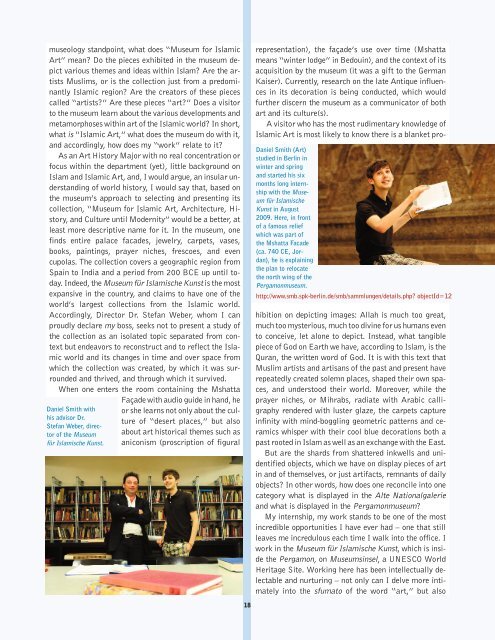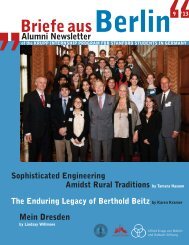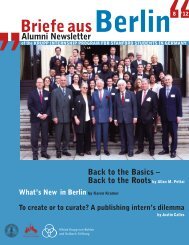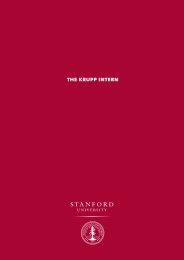Briefe aus Berlin 2009 - Krupp Internship Alumni Newsletter
Briefe aus Berlin 2009 - Krupp Internship Alumni Newsletter
Briefe aus Berlin 2009 - Krupp Internship Alumni Newsletter
Create successful ePaper yourself
Turn your PDF publications into a flip-book with our unique Google optimized e-Paper software.
museology standpoint, what does “Museum for Islamic<br />
Art” mean? Do the pieces exhibited in the museum depict<br />
various themes and ideas within Islam? Are the artists<br />
Muslims, or is the collection just from a predominantly<br />
Islamic region? Are the creators of these pieces<br />
called “artists?” Are these pieces “art?” Does a visitor<br />
to the museum learn about the various developments and<br />
metamorphoses within art of the Islamic world? In short,<br />
what is “Islamic Art,” what does the museum do with it,<br />
and accordingly, how does my “work” relate to it?<br />
As an Art History Major with no real concentration or<br />
focus within the department (yet), little background on<br />
Islam and Islamic Art, and, I would argue, an insular understanding<br />
of world history, I would say that, based on<br />
the museum’s approach to selecting and presenting its<br />
collection, “Museum for Islamic Art, Architecture, History,<br />
and Culture until Modernity” would be a better, at<br />
least more descriptive name for it. In the museum, one<br />
finds entire palace facades, jewelry, carpets, vases,<br />
books, paintings, prayer niches, frescoes, and even<br />
cupolas. The collection covers a geographic region from<br />
Spain to India and a period from 200 BCE up until today.<br />
Indeed, the Museum für Islamische Kunst is the most<br />
expansive in the country, and claims to have one of the<br />
world’s largest collections from the Islamic world.<br />
Accordingly, Director Dr. Stefan Weber, whom I can<br />
proudly declare my boss, seeks not to present a study of<br />
the collection as an isolated topic separated from context<br />
but endeavors to reconstruct and to reflect the Islamic<br />
world and its changes in time and over space from<br />
which the collection was created, by which it was sur -<br />
rounded and thrived, and through which it survived.<br />
When one enters the room containing the Mshatta<br />
Daniel Smith with<br />
his advisor Dr.<br />
Stefan Weber, director<br />
of the Museum<br />
für Islamische Kunst.<br />
Façade with audio guide in hand, he<br />
or she learns not only about the culture<br />
of “desert places,” but also<br />
about art historical themes such as<br />
aniconism (proscription of figural<br />
18<br />
representation), the façade’s use over time (Mshatta<br />
means “winter lodge” in Bedouin), and the context of its<br />
acquisition by the museum (it was a gift to the German<br />
Kaiser). Currently, research on the late Antique influences<br />
in its decoration is being conducted, which would<br />
further discern the museum as a communicator of both<br />
art and its culture(s).<br />
A visitor who has the most rudimentary knowledge of<br />
Islamic Art is most likely to know there is a blanket pro-<br />
Daniel Smith (Art)<br />
studied in <strong>Berlin</strong> in<br />
winter and spring<br />
and started his six<br />
months long internship<br />
with the Museum<br />
für Islamische<br />
Kunst in August<br />
<strong>2009</strong>. Here, in front<br />
of a famous relief<br />
which was part of<br />
the Mshatta Facade<br />
(ca. 740 CE, Jordan),<br />
he is explaining<br />
the plan to relocate<br />
the north wing of the<br />
Pergamonmuseum.<br />
http://www.smb.spk-berlin.de/smb/sammlungen/details.php? objectId=12<br />
hibition on depicting images: Allah is much too great,<br />
much too mysterious, much too divine for us humans even<br />
to conceive, let alone to depict. Instead, what tangible<br />
piece of God on Earth we have, according to Islam, is the<br />
Quran, the written word of God. It is with this text that<br />
Muslim artists and artisans of the past and present have<br />
repeatedly created solemn places, shaped their own spaces,<br />
and understood their world. Moreover, while the<br />
prayer niches, or Mihrabs, radiate with Arabic calligraphy<br />
rendered with luster glaze, the carpets capture<br />
infinity with mind-boggling geometric patterns and ceramics<br />
whisper with their cool blue decorations both a<br />
past rooted in Islam as well as an exchange with the East.<br />
But are the shards from shattered inkwells and unidentified<br />
objects, which we have on display pieces of art<br />
in and of themselves, or just artifacts, remnants of daily<br />
objects? In other words, how does one reconcile into one<br />
category what is displayed in the Alte Nationalgalerie<br />
and what is displayed in the Pergamonmuseum?<br />
My internship, my work stands to be one of the most<br />
incredible opportunities I have ever had – one that still<br />
leaves me incredulous each time I walk into the office. I<br />
work in the Museum für Islamische Kunst, which is inside<br />
the Pergamon, on Museumsinsel, a UNESCO World<br />
Heritage Site. Working here has been intellectually delectable<br />
and nurturing – not only can I delve more intimately<br />
into the sfumato of the word “art,” but also








